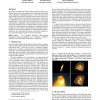APVIS
2008
14 years 4 months ago
2008
We present a technique for memory-efficient and time-efficient volume rendering of curvilinear adaptive mesh refinement data defined within extrudable computational spaces. One of...
HUC
1999
Springer
14 years 7 months ago
1999
Springer
Many novel applications take on the task of moving the personal computer away from the desktop with the approach to merge digital information with physical space and objects. These...
COSIT
1999
Springer
14 years 7 months ago
1999
Springer
Landmarks are significant in one’s formation of a cognitive map of both physical environments and electronic information spaces. Landmarks are defined in physical space as having...
ISWC
2002
IEEE
14 years 8 months ago
2002
IEEE
The representation of physical space has traditionally focused on keyphrases such as “Computer Science Building” or “Physics Department” that help us in describing and nav...
PERVASIVE
2005
Springer
14 years 9 months ago
2005
Springer
Pervasive computing environments will combine everyday physical spaces with network aware devices and services; hence providing computing behaviour that is much more entwined with...
SENSYS
2005
ACM
14 years 9 months ago
2005
ACM
MAX is a system that facilitates human-centric search of the physical world. It allows humans to search for and locate objects as and when they need it instead of organizing them ...
VISUALIZATION
2005
IEEE
14 years 9 months ago
2005
IEEE
As standard volume rendering is based on an integral in physical space (or “coordinate space”), it is inherently dependent on the scaling of this space. Although this dependen...
MM
2006
ACM
14 years 9 months ago
2006
ACM
This paper describes an interactive installation work set in a large dome space. The installation is an audio and physical rerendition of an interactive writing work. In the origi...
JCDL
2006
ACM
14 years 9 months ago
2006
ACM
The development of public libraries may have inadvertently brought the age of marginalia to a close but the advent of digital libraries could revive the practice of marginal annot...
MHCI
2007
Springer
14 years 9 months ago
2007
Springer
This paper presents how ad-hoc co-located collaborations can be supported with an arbitrary number of users that only have acces to small-size mobile displays. Our approach is bas...


